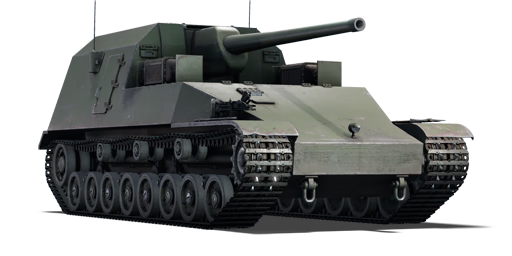



The Experimental Type 5 Gun Tank (Ho-Ri) was one of 3 tank designs for a new Japanese tank destroyer housing the new powerful Type 5 105 mm anti-tank gun to deal with the heaviest of Allied armour the US might throw at the Japanese mainland. This Ho-Ri was the final design out of the 3: unlike the 2 previous designs, it was not directly based on the Chi-Ri, but only a hull based on the Chi-Ri, featuring the same engine but with a sloped front hull design to increase armour effectiveness.
The Ho-Ri Prototype was introduced as a premium pack in Update 1.71 "New E.R.A." and was removed from sale after the 2019 New Year sale. It later returned for purchase in-game with Golden Eagles during the 2020 May sale. While very similar to the Ferdinand, it does differ slightly. While the hull of the Ho-Ri provides the same armour effectiveness of around ~200 mm, with the lower front plate being a weakness to lose driver, radio operator, and transmission, the superstructure of the tank only maxes out at 150 mm effective, with the cheeks only protecting up to 125 mm being relatively easy to penetrate for its opponents. The best course of action is to hull down the tank and peek over ridges while using its -10° depression to increase its armour effectiveness and play it in a safe sniping position. The trade-off of superstructure armour gets rewarded in forward mobility going up to 40 km/h relatively quickly. A special feature of the Ho-Ri is its elevating roof armour, to reduce its vertical silhouette, the cannon breech can elevate up, pushing the roof with it, to allow for the -10° depression it offers, this will expose the crew members but won't be much of a threat as it's a very narrow-angle for planes to strafe through, and it doesn't cause the crew to be affected by explosive overpressure.
| Ammunition | Type | Armor penetration (mm) at a distance: | |||||
|---|---|---|---|---|---|---|---|
| 10 m | 100 m | 500 m | 1000 m | 1500 m | 2000 m | ||
| APHE | 205 | 201 | 181 | 159 | 140 | 123 | |
| HE | 30 | 30 | 30 | 30 | 30 | 30 | |







 2 x (130 / 200 / 245) %
2 x (130 / 200 / 245) % 
 2 x 178 %
2 x 178 % 

Mobility | |
|---|---|
Protection |
|---|
Firepower |
|---|